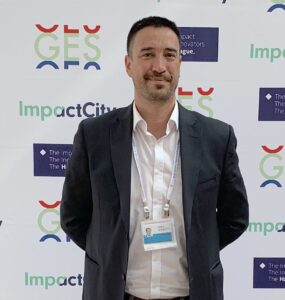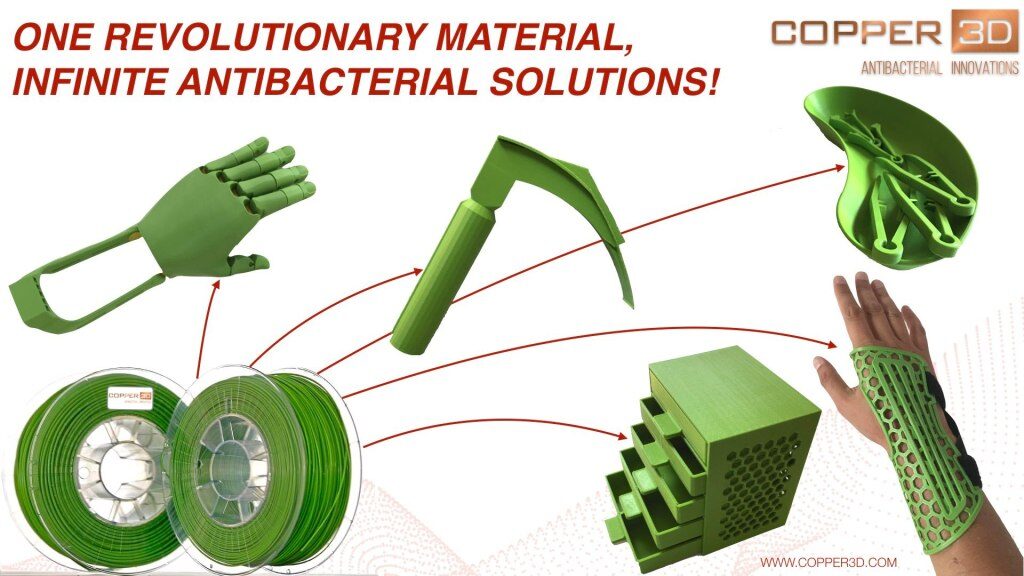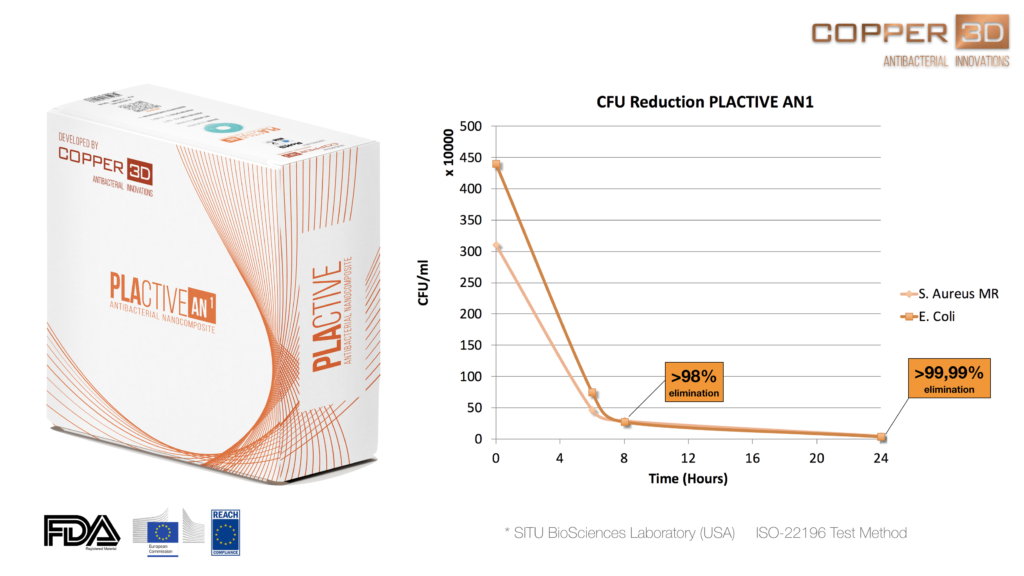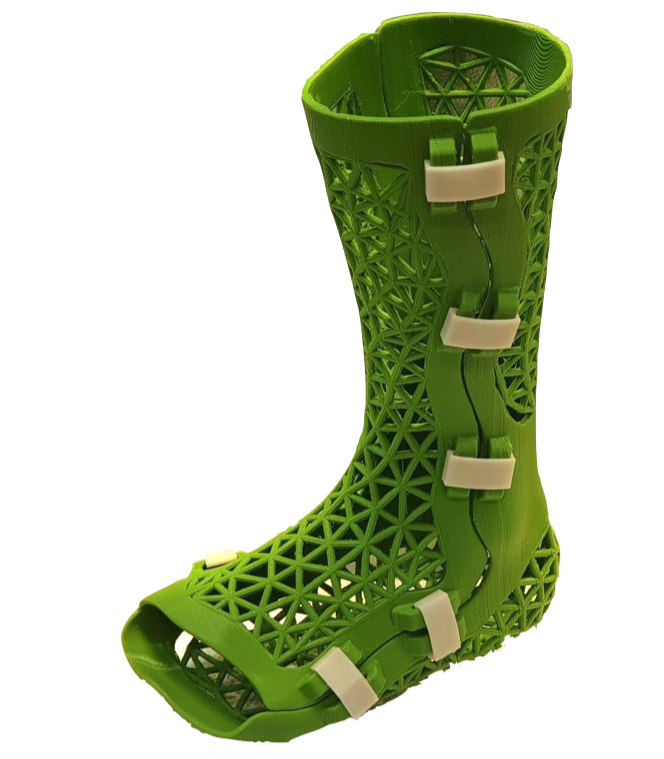Interview with Elizabeth Rogers of Kuunda 3D and Daniel Martinez of Copper 3D on Copper 3D Antimicrobial 3D Printing
The 3D printing industry continues to experience more great gradual improvements. Special mention goes to the recent development by Copper 3D with their Antimicrobial filament. In order to provide this breakthrough innovation to Africa, Copper 3D has partnered a West and East African reseller of 3D printers and materials, Kuunda 3D. In this interview, we discuss with Elizabeth Rogers of Kuunda 3D and Daniel Martinez of Copper 3D on this development.
Please explain to us the Copper 3D Antimicrobial 3D printing filament?
Martinez: We are talking about technology that allows that anyone in any part of the world, with a low-cost printer, an intelligent design, and an antimicrobial material, can create objects that are no longer only support structures (passive objects) but now we can create “active objects”, that is, objects and solutions that actively eliminate more than 99% of fungi, viruses, and bacteria.
This is really revolutionary since from now on it is possible to create and print in a matter of hours, objects such as water containers, medical devices, kits for medical procedures, orthotics and prosthetics, otoscopes, stethoscopes, shoe insoles, elements for animal care, containers for food and a wide variety of antimicrobial solutions that can contribute greatly in the containment of intra-hospital and community infections.
These types of solutions are of enormous utility, especially in some places in Africa where extra work is required to combat this type of diseases and infections.
How do you view the impact of the Copper 3D filament in Biomedical 3D printing?
The impact of this nano-copper technology is very relevant due to two factors:
3D printing is getting closer to medicine, with various low-cost solutions of all kinds. The high rate of infections and bacterial resistance is a growing problem of a global scale. When you cross these two trends you will find that at some point you will have a big problem: A lot of 3D printed medical solutions with a high bacterial burden and that is potentially dangerous for patients. That is precisely the problem that we are anticipating and solving and we believe that this will have a very positive impact on the 3D printing sector.
What machine and technology are the Copper 3D filament compatible with and is there any special post finishing work on printed models?
All Copper3D materials are compatible with most open system FDM / FFF 3D printers. They have been tested with high, medium and low range machines with very good results and objects printed with these materials require the same post-finishing work as with conventional materials.
Rogers: I’d like to add that Copper3D materials are part of the Ultimaker Material Alliance Program, meaning they have been tested with Ultimaker machines and have material profiles available in Ultimaker’s Cura slicing program. This makes them extra easy to use on Ultimaker machines, although Daniel is correct, Copper3D materials should work on any open system FDM/ FFF 3D printer!
How much would the copper 3D filament cost on the market?
Rogers: In Kenya, the local price is 9900 KSH (plus VAT), which is about US $96. Prices in other African countries will be similar. And we are currently looking for resellers in other countries who would be interested in Copper3D and our other products.
You are looking at the African 3D printing ecosystem and making a mark. What is your financial outlook concerning the African market?
I believe there is huge potential across the African continent, not just in 3D printing/ additive manufacturing. The population is young, innovative and entrepreneurial, and there appears to be a shift towards the diaspora returning home to make a positive impact locally by starting businesses and driving innovation. There are opportunities in many African countries to leapfrog old technology (such as landlines) and jump straight to the good stuff (smartphones), and this allows for several advantages, including flexibility and the ability to move quickly. However, it’s not always easy to do business in African countries and although the market potential is there, it can still be slow to adopt technologies and make changes. 3D Printing is one of these leapfrog technologies that once the industry starts to pick it up, there will be massive improvements in local manufacturing and development of local economies.
From your clinical trials and practical use of the Copper 3D filament, are there any side effects?
Martinez: Of all laboratory and clinical studies tested in patients we have not had any reports of side-effects of any kind. This does not surprise us because the concentration of nano-copper in these materials is around 100 times below the cytotoxicity threshold, therefore, they are extremely safe materials for use in patients.
Subscribe to Our Email Newsletter
Stay up-to-date on all the latest news from the 3D printing industry and receive information and offers from third party vendors.
Print Services
Upload your 3D Models and get them printed quickly and efficiently.
You May Also Like
Reinventing Reindustrialization: Why NAVWAR Project Manager Spencer Koroly Invented a Made-in-America 3D Printer
It has become virtually impossible to regularly follow additive manufacturing (AM) industry news and not stumble across the term “defense industrial base” (DIB), a concept encompassing all the many diverse...
Inside The Barnes Global Advisors’ Vision for a Stronger AM Ecosystem
As additive manufacturing (AM) continues to revolutionize the industrial landscape, Pittsburgh-based consultancy The Barnes Global Advisors (TBGA) is helping shape what that future looks like. As the largest independent AM...
Ruggedized: How USMC Innovation Officer Matt Pine Navigates 3D Printing in the Military
Disclaimer: Matt Pine’s views are not the views of the Department of Defense nor the U.S. Marine Corps Throughout this decade thus far, the military’s adoption of additive manufacturing (AM)...
U.S. Congress Calls Out 3D Printing in Proposal for Commercial Reserve Manufacturing Network
Last week, the U.S. House of Representatives’ Appropriations Committee moved the FY 2026 defense bill forward to the House floor. Included in the legislation is a $131 million proposal for...









































